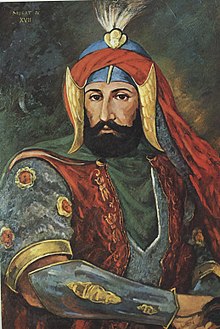Murad IV
Murad IV ( Ottoman Turkish : مراد رابع Murād-i rābi ') (* July 27, 1612 ; † February 8, 1640 ) was Sultan of the Ottoman Empire from September 10, 1623 to February 8, 1640 .
Murad was a son of Sultan Ahmed I and succeeded his uncle Mustafa I on the throne at the age of eleven. During the first nine years of his reign, his youth prevented him from taking on more than the role of a political observer. His mother Kösem Mahpeyker Valide Sultan exerted a great influence during this period . But the lessons learned were formative enough to shape his whole character and politics.
Life
The sultan's minority encouraged the anarchic elements of the state; the soldiers, spahis and janissaries , conscious of their power and ruthless because of their immunity, revolted when it suited them, demanding privileges and the heads of uncomfortable officials, including even those of the sultan's favorites. In 1631 the Spahis rose to rebellion in Asia Minor to protest against the dismissal of Grand Vizier Hüsrev. Their representatives stoned the new Grand Vizier Hafiz in the courtyard of the palace in Constantinople , pursued the Sultan himself inside the palace and threatened to depose him if he did not hand over seventeen heads of his advisors and favorites. Hafiz was handed over as a volunteer martyr; other ministers were deposed; Mustafa Pasha, Agha of the Janissaries, was saved by his own troops.
Murad was now beginning to assert himself. Hüsrev was executed in Asia Minor on his command; a plot by the Spahis to remove him was prevented by the loyalty of Köse Mehmed, Agha of the Janissaries, and Spahi Rum Mehmed ( Mehmed the Greek ). On May 29, 1632, Murad eliminated the rebels surrounded in the hippodrome after a successful appeal to the loyalty of the Janissaries. By the age of twenty he could effectively wield autocratic power .
Its severity has remained legendary. The smallest offenses were punishable by death, although merits in the past had no mitigating effect. The consumption of coffee , opium , wine and tobacco was forbidden; eighteen people are reported to have been executed in a single day for violating this rule. Throughout his reign people who violated the Sultan's authority were killed, sometimes by the thousands. According to legend, the number of his victims is said to have exceeded 100,000.
Even if he was the cruelest, he was also the bravest and most decisive of the later sultans and maintained his physical strength through constant exercises. He loved the hunt and therefore lived mainly in Adrianople . His command in the Persian War led to the conquest of Baghdad (1638), followed by an honorable peace - the Treaty of Qasr-e Shirin of May 17, 1639. He died in early 1640, barely 29 years old, due to his gout disease .
See also
literature
- Ferenc Majoros, Bernd Rill: The Ottoman Empire 1300-1922. The story of a great power . Marix, Wiesbaden 2004, ISBN 3-937715-25-8 .
- Josef Matuz: The Ottoman Empire. Baseline of its history . 4th edition. Scientific Book Society, Darmstadt 2006, ISBN 3-534-20020-9 .
- Nicolae Iorga : History of the Ottoman Empire. Depicted according to the sources. 5 volumes, Verlag Perthes, Gotha 1908–1913, reprinted Frankfurt / Main 1990.
- Gabriel Effendi Noradounghian : Recueil d'actes internationaux de l'Empire Ottoman 1300–1789. Tome I. Paris, Neufchâtel 1897. Reprint: Kraus, Nendeln 1978, ISBN 3-262-00527-4 .
Web links
| predecessor | Office | successor |
|---|---|---|
| Mustafa I. |
Sultan and Caliph of the Ottoman Empire 1623–1640 |
İbrahim |
| personal data | |
|---|---|
| SURNAME | Murad IV |
| BRIEF DESCRIPTION | Sultan of the Ottoman Empire (1623–1640) |
| DATE OF BIRTH | July 27, 1612 |
| DATE OF DEATH | February 8, 1640 |

